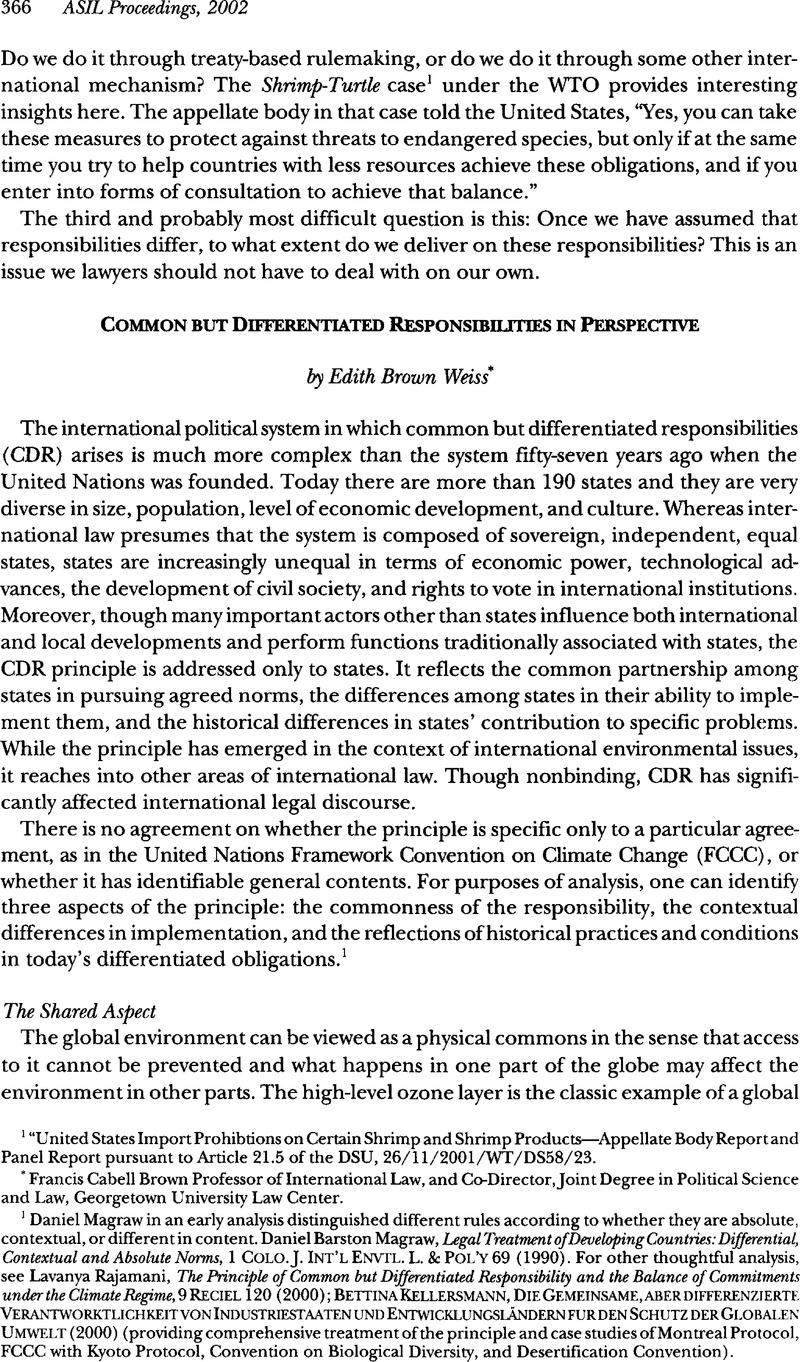Article contents
Common but Differentiated Responsibilities in Perspective
Published online by Cambridge University Press: 28 February 2017
Abstract

- Type
- Common but Differentiated Responsibility
- Information
- Copyright
- Copyright © American Society of International Law 2002
References
1 Daniel Magraw in an early analysis distinguished different rules according to whether they are absolute, contextual, or different in content. Magraw, Daniel Barston, Legal Treatment (¡/Developing Countries: Differential, Contextual and Absolute Norms, 1 Colo. J. Int’l Envtl. L. & Pol’y 69 (1990)Google Scholar. For other thoughtful analysis, see Rajamani, Lavanya, The Principle of Common but Differentiated Responsibility and the Balance of Commitments underthe Climate Regime, 9 Reciel 120 (2000)Google Scholar; Bettina Kellersmann, Diegemeinsame. aber Differenzierte verantworktlichkeit von Industriestaaten und Entwicklungsländern fur den Schutz der Globalen Umwelt (2000) (providing comprehensive treatment of the principle and case studies of Montreal Protocol, FCCC with Kyoto Protocol, Convention on Biological Diversity, and Desertification Convention).
2 Although the Montreal Protocol makes special provision for developing countries, it does not refer to “common but differentiated responsibilites.” The Protocol informed the discussions leading up to the Rio Declaration and the FCCC. See e.g. Freestone, David, The Road from Rio: International Environmental Law after the Earth Summit, 6 J. Envtl. L. 193 (1994)Google Scholar (arguing that the Protocol reflects a principle of CDR); Kellersmann, supra note 1, at 79-134.
3 Implementation of Special and Differential Treatment Provisions in WTO Agreements and Decisions, Note by the Secretariat, World Trade Organization, WT/COMTD/W/77 (Oct. 25, 2000). The author thanks Neena Shenai of the Georgetown University Law Center for her research assistance on special and differential treatment in international trade law.
4 See Cullet, Philippe, Differential Treatment in International Law: Towards a New Paradigm of Inter-state Relations, 10 Eur.J. Int’l L. 549 (1999)CrossRefGoogle Scholar.
5 United Nations Development Programme, Human Development Report 38 (1999).
6 By analogy, the Taliban government in Afghanistan caused the destruction of the large Buddha statues that were of world heritage interest, but the current government of Afghanistan will need help to remedy the problem if it chooses to do so.
7 Rothenberg, Jerome, Economic Perspectives in Time Comparisons: An Evaluation of Time Discounting, in Global Accord 307 (Choucri, Nazli ed., 1993)Google Scholar; Jerome Rothenberg, Economic Perspectives on Time Comparisons: Alternative Approaches to Time Comparisons, in id. at 355; see also Edith Brown Weiss, Intergenerational Equity: Toward an International Legal Framework, in id. at 335 (providing alternative approach and commenting on Rothenberg perspective).
8 In the negotiation of the FCCC, the modifications introduced by the United States to Article 3 (on CDR) were intended to indicate that the article applied in the specific context of the FCCC and only to those states party to the convention and that it did not constitute customary international law. Bodanksy, Daniel, The United Nations Framework Convention on Climate Change, 18 Yale J. Int’l L. 451, 501–02 (1993)Google Scholar.
- 1
- Cited by




